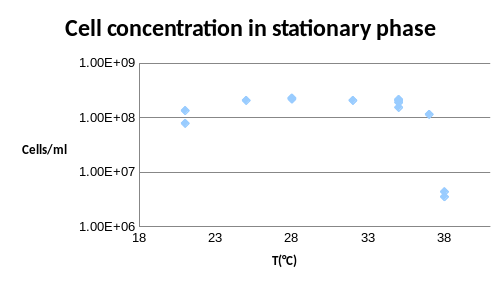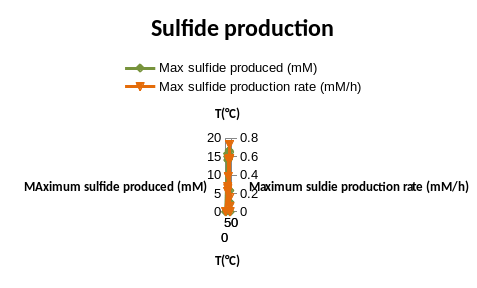Effects of temperature on biomass and sulfide production in Desulfovibrio hydrothermals (INSPIRE_Pyrite project)
Project
| Contributors | Affiliation | Role |
|---|---|---|
| Girguis, Peter | Harvard University | Principal Investigator |
| Clarke, David | Harvard University | Co-Principal Investigator |
| Allison, Dicky | Woods Hole Oceanographic Institution (WHOI BCO-DMO) | BCO-DMO Data Manager |
Effects of temperature on biomass and sulfide production in Desulfovibrio hydrothermalis strain AM13 across a range of biologically relevant temperatures. Measured biomass production (cell concentration in stationary phase) and maximum sulfide concentration produced and maximum sulfide production rate in the exponential phase.
Figures included with the data:


Inoculum: 200 µl stock culture (stationary phase) into 50 ml medium (expected at t0: 8.0 E+5 cells/ml).
"The time between t0 and tend is variable. We wait to reach the stationary phase. The rate is the maximum rate (exponential phase of sulfide production)." A. Picard, personal communication.
Method for cell counting: Cell cultures were fixed with 3.7% formaldehyde for cell counts. Between 100 and 1,000 microliters of fixed sample were filtered onto a 0.2 µm GTBP polycarbonate filter (Millipore), stained with DAPI (4’,6’-diamidino-2-phenylindole; Sigma), and counted via epiflourescent microscopy, using a Zeiss Axiophot scope equipped with objectives capable of 20x, 60x and 100x magnification.
Method for sulfide concentration: Spectrophotometric quantification using standard curve after Cline, 1969.
adapted to the range of concentrations in the cultures.
| File |
|---|
DhydroBioProd.csv (Comma Separated Values (.csv), 1.26 KB) MD5:6025ae334770865c9c6c7b2e019b4960 Primary data file for dataset ID 638091 |
| Parameter | Description | Units |
| phase | growth phase - exponential or stationary | text |
| temp | temperature | degrees Celsius |
| numb_cells_t0 | number of cells at time = 0 (beginning) | cells per milliliter |
| numb_cells_tend | number of cells at time = end (of experiment) | cells per milliliter |
| max_sulfide_prod | maximum sulfide concentration produced | milliMoles |
| std_error_prod | standard error of maximum sulfide concentration | milliMoles |
| max_sulfide_prod_rate | maximum sulfide production rate | milliMoles per hour |
| std_error_rate | standard error of maximum sulfide production rate | milliMoles per hour |
| Dataset-specific Instrument Name | Epifluorescence Microscope - Zeiss Axiophot |
| Generic Instrument Name | Fluorescence Microscope |
| Dataset-specific Description | Light microscope equipped for bright field (both transmitted and reflected), phase contrast, transmitted and reflected polarization and Nomarski differential interference contrast microscopy, as well as epifluorescence.
|
| Generic Instrument Description | Instruments that generate enlarged images of samples using the phenomena of fluorescence and phosphorescence instead of, or in addition to, reflection and absorption of visible light. Includes conventional and inverted instruments. |
| Dataset-specific Instrument Name | spectrophotometer |
| Generic Instrument Name | Spectrophotometer |
| Generic Instrument Description | An instrument used to measure the relative absorption of electromagnetic radiation of different wavelengths in the near infra-red, visible and ultraviolet wavebands by samples. |
INSPIRE Track 1: Microbial Sulfur Metabolism and its Potential for Transforming the Growth of Epitaxial Solar Cell Absorbers (INSPIRE_Pyrite)
This INSPIRE award is partially funded by Biological Oceanography Program in Division of Ocean Sciences, in the Directorate of Geosciences; the Electronic and Photonic Materials Program in the Division of Materials Research, Directorate of Mathematical and Physical Sciences.
A simple idea motivates this project: By characterizing the mechanisms underlying pyrite film deposition by subsurface microbes living at hydrothermal vents, can approaches be developed to controllably grow high-purity pyrite films that could be used to produce low-cost photovoltaic solar cells? Recent in situ studies at hydrothermal vents have found "subsurface" microbes associated with the deposition of large crystalline metal sulfides (up to 1.1 millimeters), including iron pyrite. In laboratory incubations, vent microbes specifically deposited pyrite (FeS2), devoid of Zn, Cu and other metals that were abundant in the liquid media. Abiotic incubations did not exhibit this specificity. The investigators hypothesize that, in situ, microbes deposit pyrite via a number of potential processes, including a physiological process called extracellular electron transfer (EET), wherein microbes shuttle electrons to/from minerals. In situ, EET-enabled microbes may use conductive minerals to electrically access oxidants, and deposit pyrite on these surfaces. Vents are thus natural bioelectrochemical cells, which grow metal sulfides via microbial and abiotic electrochemical processes, though the details and mechanisms remain to be determined. This project is aimed at elucidating the mechanisms underlying microbial FeS2 pyrite bio-deposition, and assessing how microbes might be used to deposit epitaxial films for solar cells absorbers. FeS2 pyrite has been identified as prospective low cost solar absorbers because of their abundance, suitable band-gap (~0.95 eV) and high optical absorbance. Microbial pyrite film deposition at lower temperatures (<100 C) might offer a radically new, low cost approach to creating large area PV solar cells. Nothing is currently known about the mechanisms underlying microbial pyrite growth, though the large crystal sizes suggest epitaxial deposition is favored over re-nucleation implying that, once nucleated, epitaxial growth can occur. A series of experiments using natural vent microbial communities and isolates will be conducted to determine: A) environmental factors that influence bio-deposition; B) potential molecular mechanisms; C) the microstructural and electrical properties of these films; and D) whether bio-deposition by single species or consortia yields films of highest purity, size and homogeneity.
The project is both highly-integrated and transformative. It is relevant to our understanding of microbial sulfur cycling, as little is known about how microbes mediate crystalline pyrite formation and the degree to which this influences sulfur isotope geochemistry. Molecular studies will be used to interrogate relevant microbial metabolic processes and constrain the possible mechanisms of pyrite film growth, which is critical to advancing our ability to grow FeS2 films for device applications. Understanding the effects of substrate crystallography and electrical conductivity on the growth morphology will further inform our knowledge of microbial pyrite deposition. Notably, this research differ from existing biomimetic approaches. The studies are not focused on crystal growth via tethered peptides or synthetic extracellular matrices. Rather, they aim to advance our understanding of natural biodeposition, use the insights gained to grow pyrite materials and devices.
| Funding Source | Award |
|---|---|
| NSF Division of Ocean Sciences (NSF OCE) |
[ table of contents | back to top ]